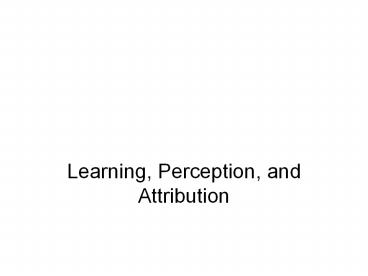Learning, Perception, and Attribution - PowerPoint PPT Presentation
Title:
Learning, Perception, and Attribution
Description:
Learning, Perception, and Attribution TWO KEY LEARNING PROCESSES AND E-LEARNING Learning is a relatively permanent change in behavior based on practice or experience. – PowerPoint PPT presentation
Number of Views:117
Avg rating:3.0/5.0
Title: Learning, Perception, and Attribution
1
- Learning, Perception, and Attribution
2
TWO KEY LEARNING PROCESSES AND E-LEARNING
- Learning is a relatively permanent change in
behavior based on practice or experience. Unless
learning takes place, few employees would be able
to perform their jobs satisfactorily.
3
Two Key Learning Processes and e-Learning
- Modeling and Shaping
- a. Modeling occurs through imitating someone.
- b. Shaping occurs through rewarding small steps.
- Cognitive Learning
- Assumes that learning is complicated including
motivation and hunches. - b. Informal learningorganization does not
determine or design the learning process.
4
Cognitive Learning
- The learners orientation influences the amount
of cognitive learning. A mastery orientation
relates to a dedication to increasing ones
competence on a task. - With performance orientation, learners focus on
how well they perform on a task and making
comparisons with others.
5
Two Key Learning Process and e-Learning
(continued)
- Informal learning includes practical,
intrapersonal, interpersonal skills, and cultural
awareness. - E-Learning is a Web-based form of computer-based
training. - a. Used widely when learners are geographically
dispersed - b. Cognitive process of self-motivation and
- self-discipline are needed.
6
Learning Styles
- People learn best in different ways, such as
through studying versus doing - Visual, Auditory, and Kinesthetic Styles
- Visual learners learn best by seeing.
- Auditory learners rely on hearing.
- Kinesthetic learners learn best by touching and
moving - Most learners combine the three styles to some
degree.
7
Learning Styles
- Learning styles have also been divided into four
orientations based on four stages of the learning
cycle - concrete experience?observations and
reflections?formation of abstractions and
generalizations?hypotheses to be tested, leading
to new experiences. The four learning
orientations stemming from the cycle are
8
Learning Styles and Implications
- 1. An orientation toward concrete experiences
that emphasizes being involved in experiences and
dealing with human interactions in a personal
way. - 2. An orientation toward reflective observation
that emphasizes understanding meanings. - 3. An orientation toward abstract
conceptualization that emphasizes applying logic,
ideas, and concepts. - 4. An orientation toward testing implications of
concepts in new situations that emphasizes
actively influencing people and changing
situations.
9
Individual Differences Related to Skill
Acquisition
- People with high mental ability and the ability
to concentrate learn better. - In one study, air traffic controllers who
acquired more skills, scored higher on (a)
cognitive ability test, and (b) warmth
factorwarm, outgoing, attentive to others,
cooperative, generous, and trusting.
10
Perception
- Perception deals with the various ways in which
people interpret things in the outside world and
how they act on the basis of these perceptions.
Much phenomena is interpreted in terms of how we
perceive it, rather than what it really is.
11
Contributors to Perceptual Distortions
Emotionally Charged Stimulus
Perceptual Distortion
Person as Receiver
Mental Processes Denial Stereotyping Halo
effect Projection Selective Perception
12
External Factors inSelective Screening
Size
Intensity
Novelty and familiarity
SelectiveScreening
Contrast
Repetition
Motion
13
Internal Factors inSelective Screening
Personality
SelectiveScreening
Learning
Motivation
- Perceptual set
14
Characteristics of the stimulus
- Perceptual problems are most likely encountered
when the stimulus or cue to be perceived affects
the emotional status of the perceiver. The
perception of a stimulus or event depends on the
emotions, needs, attitudes, and motives of a
person.
15
Mental processes of people
- The general purpose of these perceptual shortcuts
is usually to make the reality less painful or
disturbing. As such, these mental processes are
types of defensive behavior.
16
Mental processes of people
- Denial. We block out the existence of painful
sensory information. - Stereotyping. We lessen discomfort when we
encounter a person who does not fit a stereotype
by looking for behavior that conforms to the
stereotype. - Halo effect. People may color everything that
they know about a person because of one
recognizable favorable or unfavorable
characteristic. - Projection. We project out own faults on to
others instead of making an objective appraisal
of the situation. - Selective perception. People use this mechanism
when they draw an unjustified conclusion from an
unclear situation. (They perceive what they want
to.)
17
Attribution Theory and Blame
- Two common attribution errors are (a) the
fundamental attribution error, and (b)
self-serving bias. - The fundamental attribution error is the
tendency to attribute behavior to internal causes
when focusing on someone elses behavior - The self-serving bias is the general tendency to
attribute ones achievements to good inner
qualities, while attributing failure to adverse
factors within the environment. - People attribute causes based on three
dimensions consensus (did others do it?)
consistency (stable performance?) and
distinctiveness (unusual for the person?)
18
Attribution Theory and Blame, continued
- People attribute behavior to external causes when
they perceive high consensus, low consistency,
and high distinctiveness. - People attribute behavior to internal causes when
they perceive low consensus, high consistency,
and low distinctiveness. - Blame is natural when harmful events take place,
but can block problem solving.
19
Attributions of Internal andExternal Causes of
Behavior
Consistency is high Distinctiveness is
high Consensus is high
Attribution ofexternal causes
Consistency is high Distinctiveness is
low Consensus is low
Attribution of internal causes
Consistency is low
Attribution of eitherexternal or internalcauses































